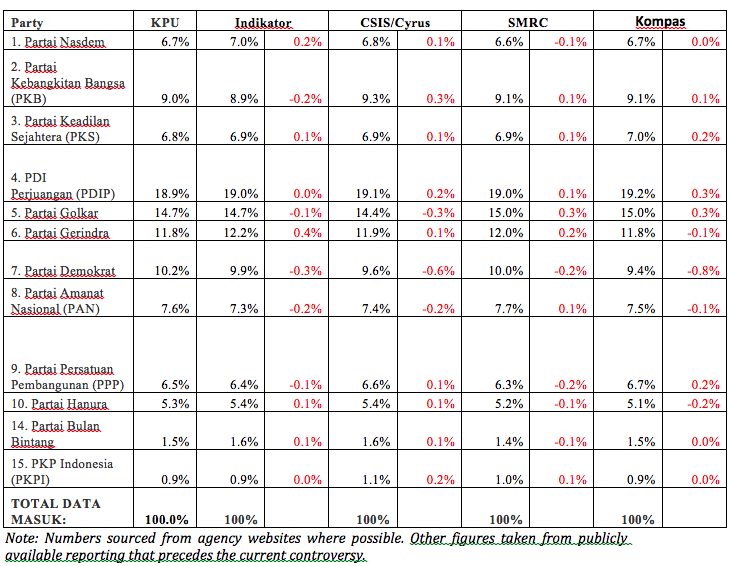By Diane Zhang
Within hours of polls closing in Wednesday’s Indonesia’s presidential election, both Joko Widodo and Prabowo Subianto had publicly claimed victory. Doubt thus remains over who will be installed as Indonesia’s seventh president, ahead of the electoral commission announcing an official result on 22 July.
How is it possible that both sides believe they have won this time? More importantly, with almost two weeks until the official result, what is the basis for each camp’s declaration?
Both candidates based their claims of victory on the results of so-called "quick counts" conducted on election day. A quick count is a tally of the actual votes at certain polling stations, selected to provide a representative sample of the overall result. Done properly, a quick count is an extremely accurate measure of the final election result.
(Typically, a quick count forecasts the election result plus or minus a margin of error (usually 1%) at a 99% confidence level. Statistically, this means that 99 times out of 100 the election result should fall within 1% either side of the quick count figure.)
Quick counts take advantage of the fact that each of Indonesia’s approximately 480,000 polling stations finish their count on polling day, after which the electoral commission takes many days to aggregate their individual counts to reach an overall result. This time lag makes quick counts a crucial accountability mechanism to guard against the tallies being manipulated. Electoral experts Eric Bjornlund and Glenn Cowan (the latter of whom invented quick counts in the 1980s) call quick counts ‘the only definitive vote count verification mechanism’.
The success of quick counts to accurately forecast election results has seen them used in the 2004 presidential election, both the 2009 and 2014 legislative and presidential elections, as well as in numerous of Indonesia’s hundreds of elections for district heads and governors.
Table 1: Comparison between election and quick count results in 2004 presidential election.

Table 2: Comparison between election and quick count results in 2009 presidential election.

The number of agencies conducting quick counts has proliferated over time. In 2014, the results of 12 quick counts were published the day after the election on the front page of Kompas, Indonesia’s leading newspaper.
Seven of these 12 quick counts declared Joko Widodo the winner by a margin of between 4% to 6.88%, with an error margin of ±1% (SMRC’s margin of error is ±0.68%, because of their larger sample). Another quick count, by Populi Center, also shows a Jokowi victory, but by a margin of just under 1.9%, less than the count’s ±1% margin of error.
Table 3: “Jokowi win” quick counts

Source: Kompas, rounded to two decimal points.
Four other quick counts showed a Prabowo Subianto victory. Two of these counts had Prabowo ahead by 0.2% and 1%, less than each count’s stated margin of error (although LSN did not report their margin of error). The other two, by Puskaptis and IRC, showed a Prabowo victory with a margin of between 2.2% and 4%.
Table 4: “Prabowo win” quick counts

Which of these quick counts should we believe? The credibility of the agencies conducting the quick counts is crucial, because they are easily manipulated. Sampling methodology is key.
A quick count is an accurate predictor of the final result if the sample of voting stations selected is representative of the voting patterns of the whole of Indonesia. Conversely, an agency can easily inflate the result for one candidate by skewing their sample to include more polling stations from their strongholds.
The most credible agencies have all called Jokowi the winner, and all by similar margins. SMRC, Indikator and CSIS all have strong track records for accuracy and integrity in quick counts and public opinion polling over a period of time. Additionally, Kompas is Indonesia's de facto paper of record. All accurately predicted the outcome of the 2014 legislative election within 0.5% of the final result.
Table 5: 2014 Legislative election result and quick count results

Conversely, the credibility of the agencies that showed a Prabowo win has been questioned. The Australian National University political scientists Ed Aspinall and Marcus Mietzner convincingly list instances of all four agencies publishing inaccurate polls that favour Prabowo or his Gerindra party. One has previously been embroiled in controversy over manipulation of a quick count.
Prabowo supporters also question the credibility of quick counts showing a Jokowi win, because they believe those agencies favour Jokowi. At the think tank CSIS, the executive director is an advisor to Jokowi's campaign team. The head of SMRC, Saiful Mujani, openly criticises Prabowo on Twitter. Burhanuddin Muhtadi, the head of Indikator, has re-tweeted material that supports Jokowi. Irrespective of their political leanings, however, there has never been any suggestion of these institutes manipulating the outcomes of quick counts or opinion surveys.
Where these institutes have attracted scrutiny in this election has been because none published polls in the weeks leading into the election. (SMRC published the results of several polls the day before the election.) Aaron Connelly of the Lowy Institute speculated that CSIS, SMRC and Indikator may have withheld publication of polls out of concern that their release would damage the Jokowi campaign.
The nail in the coffin for Prabowo, however, is that the count jointly conducted by state-owned radio station RRI and official newswire Antara has Jokowi winning by 5.42%, in line with the results of other credible agencies. Critics who accuse CSIS, Indikator, SMRC, and other institutes of supporting Jokowi cannot make the same claim against RRI-Antara.
In addition to these quick counts, the Prabowo camp has also released a so-called "real count", conducted by the Prosperous Justice Party (PKS), a member of the coalition supporting Prabowo. Not surprisingly, the “real count” supports a Prabowo victory. This count claims to tally results from 83 million votes allegedly from 270,000 polling stations across Indonesia, much larger than the quick count samples, most of which use results from 2000 polling stations.
Increasing the number of polling stations only improves accuracy though if the stations are chosen using statistical methodology to be a representative sample of the overall population. SMRC did just that, increasing their sample to 4000, which reduced their margin of error from 1% to 0.68%.
There is no evidence that PKS applied the same rigour. In fact, during the legislative election in April, PKS announced their own "real count" results showing that the party received 9.44% of the vote, much higher than PKS’s actual vote of 6.8%. Their "real count" was far less accurate than the quick count results of the credible agencies, that were all within 0.2% of PKS’s final result.
The accuracy of credible quick counts also means that declaring victory before the final result is not unheard of in Indonesia. In the 2012 Jakarta gubernatorial election, incumbent governor Fauzi Bowo conceded defeat to Joko Widodo based on a 7% margin in quick count results.
Incumbent President Susilo Bambang Yudhoyono is more cautious, however. In 2009, after the quick count indicated that Yudhoyono had received over 60% of the vote, he came out and said “although quick count institutes show our success, we will still wait for the KPU results.”
Jokowi’s critics may argue that his victory declaration is premature and that may be the case. However, the charge leveled at Prabowo is far more serious. His camp is widely considered to have engineered quick counts in his favour so as to call into question the validity of quick count results by credible agencies. Such a move is consistent with the smear tactics that he has employed throughout the campaign.
What does all of this mean? First, the weight of credible quick counts stands with Jokowi. One quick count by itself could be wrong, but multiple credible counts, conducted independently, with similar results constitute overwhelming evidence of the election's final result.
Second, Jokowi's winning margin is not small. In absolute terms, 4-5% is millions of votes, and is well above the margin of error of all the credible quick counts.
Third, regardless of who the electoral commission declares as winner on 22 July, one side will challenge the result at Indonesia’s constitutional court. Should the official results show a Jokowi win with a margin of similar to credible quick counts, the constitutional court faces the easier decision of upholding a result that is supported by credible quick counts.
The worst-case scenarios for Indonesia is if the final result released on 22 July shows a Jokowi win but with a much smaller margin, or even overturns the quick counts’ consensus. Under the first scenario, Prabowo and his supporters may not accept a constitutional court decision to uphold a Jokowi win. Under the second scenario, Jokowi supporters will rightly question the validity of the vote tally process, the integrity of the election result and may even claim that Prabowo “stole” the election illegally.
If either of these scenarios takes place, Indonesia faces rocky times ahead.
Diane Zhang is a Sydney-based economist working on public financial management issues in Indonesia.



